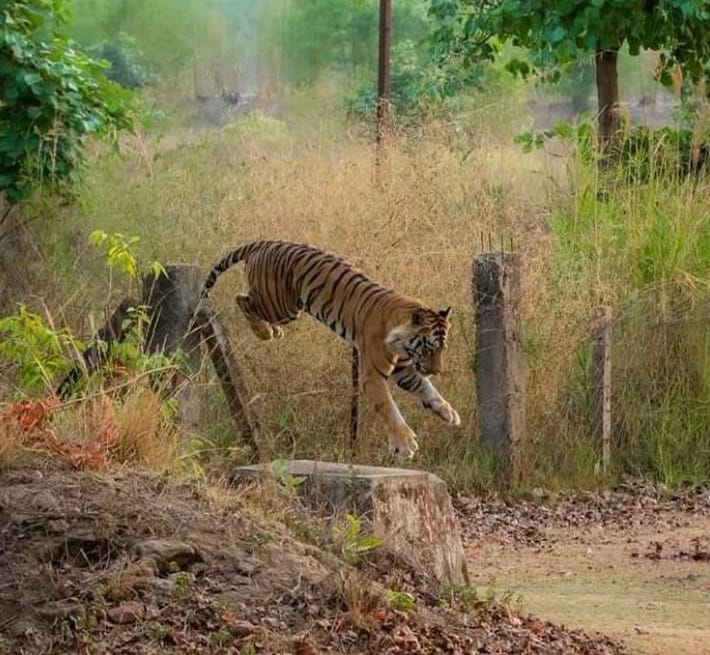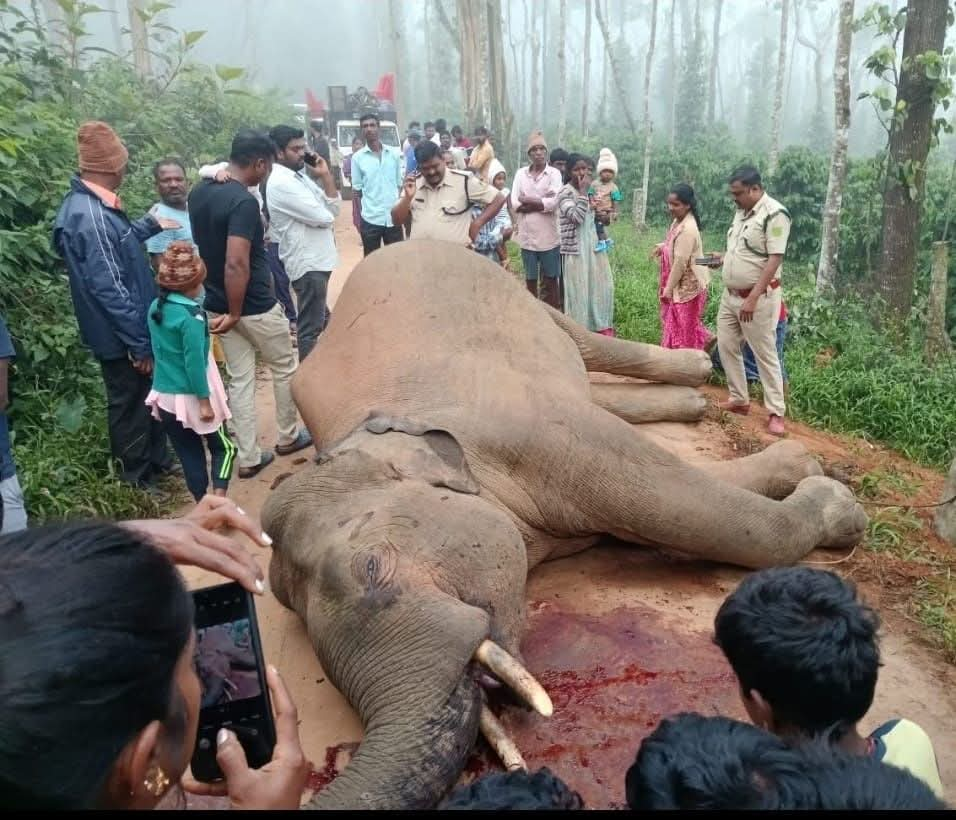
R S TEJUS:
People’s interference in tiger rescue operations at Bandipur Tiger Reserve, Karnataka turns tragic, impacting wildlife conservation.
The incident at Badagalapura village, under the Nugu Range of Bandipur Tiger Reserve, Karnataka, on October 16 once again shows how reckless human behaviour can impact and destroy a well-planned wildlife operation.
A young male tiger in its prime, frightened by the sudden presence of an unruly, huge, and violent crowd of 400 villagers and farmers, ran in utter panic.
The frightened tiger neither attacked nor provoked anyone. It simply tried to escape from an uncontrollable mob who refused to let the Karnataka Forest Department (KFD) – forest staff and forest officials or even the Karnataka State Police to perform their duties.

HOW THE OPERATIONS COLLAPSED?
For almost a month, this male tiger had been wandering near the forest edge, occasionally preying on cattle. This is a natural act for a dispersing young male tiger searching for its territory.
To prevent further incidents, the forest department had organized a rescue operation to tranquilize and relocate it safely from the forest edge. Around 50 trained forest staff were deployed amidst an escalating conflict situation.
WELL-PLANNED RESCUE OPERATION
From the beginning, the forest officers did everything to follow the rule book and the standard operating procedure (SOP). They created safety zones and repeatedly urged villagers to stay back in their houses.
Loudspeakers were used, warnings were issued, and the forest staff even tried to form a human barrier to keep the unruly and disruptive crowd away. But alas!
More than 400 villagers ignored every instruction that was issued. They pushed forward, shouted, and broke the operation’s perimeter taking selfies, pictures and made video footage of the delicate operations.

MISSED DARTING PROCEDURE
When the dart was fired, it missed the exact spot it was supposed to hit the highly disturbed tiger. A single dart miss changed the situation completely.
The tiger, terrified by the commotion created by the excited and attention-seeking crowd, bolted. In that moment of chaos, a man who was gleefully watching the tiger operations (in fact, being a big hindrance in the tiger’s path) was injured.
VIOLENT MOB TAKES FOREST, POLICE STAFF AS HOSTAGES
The crowd’s reaction was violent and they became vicious, savage and brutal. They turned on the forest officials and forest staff, and they attacked forest and police personnel both.
Range Forest Officer Vivek and his frontline forest staff were taken as hostages. The violent and aggressive crowd, in fact, demanded that senior forest officers arrive immediately at the spot while they had turned the delicate rescue operations into a “tamasha”.
Assistant Conservator of Forests (ACF) Naveen rushed to the spot to bring the horrific situation under control.
RESCUE EFFORT BECOMES A RIOT
What was meant to be a rescue became a riot. And the poor tiger which had done nothing became a pawn in the hands of the savage crowd.
The Karnataka Forest Department’s best efforts to protect both people and the young frightened tiger were crushed not just by mob ignorance but also because of their greed, curiosity and craving for unholy excitement.
A TASK FEW CAN IMAGINE
Capturing a tiger is no ordinary feat. It needs lot of courage, experience and dedication. Even for trained forest staff, it is among the most dangerous and mentally exhausting operations.
Darting a tiger in the wild requires focus, calmness, and precision – none of which are possible when hundreds of unruly crowd and intemperate people are screaming, blocking the forest team and baying for the tiger’s blood.
Despite this, the Karnataka Forest Department officers and frontline forest staff stood their ground, risking their lives to prevent greater harm to the frenzied mob of 400 people.
KFD REMAINED STEADFAST
Such delicate rescue operations of a healthy, big tiger test every ounce of courage and patience. And the officials and forest staff of Karnataka Forest Department (KFD) stood their ground and carried out the operations with presence of mind and composure.
Yet the same frontline forest staff and dedicated forest officers who protect forests are often abused, beaten, or taken hostage by mobs who know nothing of the risks and dangers involved.

A TIGER CONDEMNED FOR NO FAULT
This tiger was neither old nor sick. It was a young male in its prime, doing what wild animals do – moving in search of space.
Now, because of human arrogance and selfishness, it is likely to be captured and confined for life, living out its days in captivity under stress and trauma.
For an animal to thrive, to roam, and rule, such captivity is torture. It will pace endlessly, haunted by fear – it never created. The tragedy lies not in the tiger’s actions, but in how humans responded to them and behaved like hooligans and that too in an uncivilized manner.
BADAGALAPURA’S HISTORY OF CONFLICT
Badagalapura in the vicinity of Bandipur Tiger Reserve has a long, bitter history of human–wildlife conflict.
At least five such incidents have taken place here in the past, including one where a tiger was shot dead by locals.
Each time, the pattern is the same – cattle kill, mob anger, utter chaos, violent behaviour of people and either a dead or captured tiger or leopard. Lessons are never learned.
RISING HOSTILITY AGAINST WILDLIFE & FOREST STAFF
This anti-wildlife and anti-KFD sentiments are spreading fast across the state where tiger reserves and sanctuaries are there. Eight years ago, near the Cauvery Sanctuary, villagers held similar protests against elephants and forest officers. Today, that hostility has only deepened and worsened.
Studies by field ecologists show that in nearly all human–wildlife conflicts, it is human interference that sparks the violence, yet it is the animal and the KFD that takes the blame.
Repeated mob violence like these hints at a deeper hidden agenda. Such cases and incidents must be investigated by an impartial authority. Whether it is political influence, interference by people’s representatives, misinformation, or organized manipulation, something larger is at play.

SYSTEMIC FAILUREA & POLICY GAPS
The Nugu Range, Bandipur Tiger Reserve exposes a major gap in human-wildlife conflicts management. There must be a clear inter-departmental policy for such operations.
Coordination between the forest, police, fire, and revenue departments is crucial. Crowd control and emergency protocols must be defined, refined, rehearsed, and strictly enforced.
The senior leadership of the Karnataka Forest Department must also spend more time on the ground – conducting regular field visits, assessing conflict-prone zones, and guiding local teams in real time. Leadership should begin in the field, not from plush offices, is what the situation demands.
NO COMPENSATION BUT PENALTIES SHOULD BE IMPOSED
The cost of the injured villager’s treatment should be borne by the KFD. But this should not be as compensation for his utter recklessness, but as an acknowledgment that proper coordination failed.
All the people in the huge mob should be identified, warned and cautioned by the police just as any incident of “Law and Order Breakdown” so that such incidents do not recur again and again.
Strict penalties of Rs 500 per person should be imposed on people when they gather and become violent in the rescue operations of a tiger, leopard or elephant.

In fact, with the Nugu Range incident at Bandipur Tiger Reserve, the state government should take a policy decision for imposing penalties and fines on local people and villagers who were responsible for creating ruckus and chaos in such a horrendous situation.
REPAIRING A BROKEN RELATIONSHIP
However, locals are essential for conservation. Without their support, protecting forests is impossible. But this trust has broken down. Anger and misinformation now dominate social media & interactions. The KFD must rebuild that trust through open communication and consistent engagement.
At the same time, the focus must shift back to protection by not replenishing waterholes, by not providing food and fodder to the wildlife, but by keeping wildlife within safe natural spaces. Forests are not zoos, and animals are not spectacles for human interference.

THE REAL VICTIM
In nearly every human–wildlife conflict, people have created such problems, and the innocent animal dearly pays for it.
The tiger at Nugu Range, Bandipur did not attack at any time but it ran in fear. Yet, this tiger in its prime will be the one condemned to a cage, while those who caused the chaos walk free.
The truth is simple: the tiger is not the enemy; our ignorance is.
If such mob behaviour continues unchecked, India’s forests will one day fall silent — emptied not by poachers, but by the violence at our own hands.
